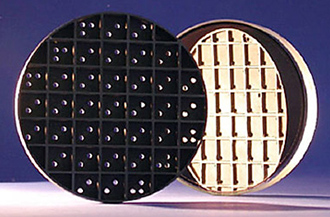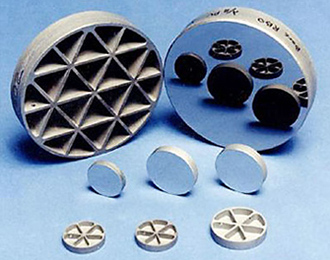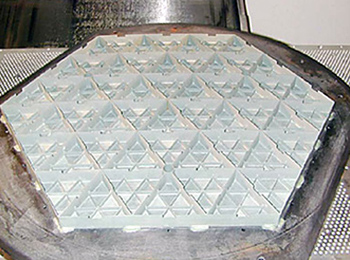Image Metrology Solutions
AOX excels in Product Design, Rapid Prototyping, Manufacturing, Maintenance and Repair of Electro-Optical and Opto-Mechanical devices.
AOX excels in Product Design, Rapid Prototyping, Manufacturing, Maintenance and Repair of Electro-Optical and Opto-Mechanical devices.
AOA Xinetics’ expansion of its silicon carbide facility now means that lightweight optics and precision structures in the 1.5-meter class are possible. CERAFORM Silicon Carbide provides a superior combination of material properties and forming technologies. High specific stiffness, lightweight designs, and low inertia, previously possible only in beryllium, are now possible in a material which exhibits the thermal performance of the low expansion glasses.
Recent thermal strain data taken from 5 to 300 Kelvin show CERAFORM Silicon Carbide to be thermally stable to 20 ppb. Recent processing breakthroughs attained the fabrication of meter class mirrors with areal densities of 5 kg/m2. CERAFORM Silicon Carbide can be directly polished to <10 Angstroms rms surface finish and with figures better than 1/10 PV. AOA Xinetics also uses the CERAFORM casting process for complex mechanical structures.
AOA Xinetics’ expansion of its silicon carbide facility now means that lightweight optics and precision structures in the 1.5-meter class are possible. CERAFORM Silicon Carbide provides a superior combination of material properties and forming technologies. High specific stiffness, lightweight designs, and low inertia, previously possible only in beryllium, are now possible in a material which exhibits the thermal performance of the low expansion glasses.
Recent thermal strain data taken from 5 to 300 Kelvin show CERAFORM Silicon Carbide to be thermally stable to 20-ppb. Recent processing breakthroughs attained the fabrication of meter class mirrors with areal densities of 5-kg/m2. CERAFORM Silicon Carbide can be directly polished to <10-Angstroms rms surface finish and with figures better than 1/10 PV. AOA Xinetics also uses the CERAFORM casting process for complex mechanical structures.


Polished Family of SiC Mirrors
AOA Xinetics has worked with several companies to develop processes to directly polish CERAFORM SiC to a smooth finish of better than 10Ã… rms. This represents extreme environments. For optical finish requirements better than 10 Ã… rms a silicon cladding is necessary. The cost of the cladding versus the increased cost of the direct polishing must be assessed in terms of the overall thermal stability requirements to determine the best polishing approach.

1m SiC Hex Mirror

1m Closed Back Lightweight Primary Mirror

Metering Structure for an all SiC Telescope

20 inch SiC Mirror

Thermal conductivity determines a mirror’s response to a changing heat flux environment. For space-based applications, higher thermal conductivity decreases the cool-down cycle time and increases instrument availability. For high heat flux applications, a high conductivity minimizes the distortion and coating stresses induced by rise in surface temperature. The left figure plots thermal conductivity data for AOA Xinetics CERAFORM SC from 5° to 300° Kelvin.
Thermal diffusivity measures a material’s ability to adjust their temperature to that of their surroundings. It’s desirable to attain a high value here to minimize gradients and so distortions in optical systems. CERAFORM SiC has diffusivity comparable to silicon and substantially higher than other metals such as Beryllium and Aluminum considered as alternatives.

A material’s thermal expansion coefficient dictates a mirror’s response to a thermal stimulus. The Thermal Expansion figure shows response for different materials from room temperature down to the cryogenic temperature regime. Ultra-Low Expansion (ULE) glass is titanium doped fused silica specially formulated for near-zero expansion at room temperature. It is superior in terms of thermal stability from the 5° to 300° Kelvin temperature range considered and features a Da at 5° Kelvin of 10 ppb/°K. Next best are single crystal silicon and CERAFORM silicon carbide which contains 30% free silicon in an alpha SiC matrix. The silicon based materials feature a Da at 5 Kelvin of 20 to 30 ppb/K. The metals, beryllium and aluminum, have the highest thermal expansivity with beryllium becoming more attractive as the temperature drops into the 77 Kelvin regime. The meals have a Da at 5 Kelvin of 10 ppb/K.

Thermal gradients through the thickness of a mirror produce bending or bowing and result in surface distortion. The higher a mirror’s thermal stability figure of merit (ka) the less susceptible the mirror is to thermally induced distortions. CERAFORM SiC and single crystal silicon provide unsurpassed thermal stability over the entire 5 to 300 Kelvin temperature range. Silicon is limited to simple fabrication shapes and its properties are anisotropic. Beryllium, though inferior to the silicon-based materials, is significantly better than aluminum and like the silicon-based materials improves as the temperature drops. The least thermally stable material is ULE. As the environment cools, ULE is very susceptible to thermal-induced bowing. CERAFORM SiC resists thermal bowing the best of all materials and is the most dimensionally stable.

CERAFORM SiC has proven stable from both a macroscopic (figure distortion) and a microscopic (surface finish) perspective. Of particular concern in optics applications is the thermal strain experienced at cryogenic temperatures. The CTE homogeneity shown is a factor of 3 better than beryllium through cryogenic extremes. Below 100° Kelvin the instantaneous thermal expansion is nearly zero; key to dimensionally stable structures and optical stability. The DCTE of silicon carbide at 5 Kelvin is 20 to 30 ppb /°C as compared to 80 to 120 ppb/°C for beryllium. Only fused silica is better in terms of DCTE with a 5 – 10 ppb/°C change. In addition no measurable change has been detected for repeated thermal cycles or so called thermal hysteresis.